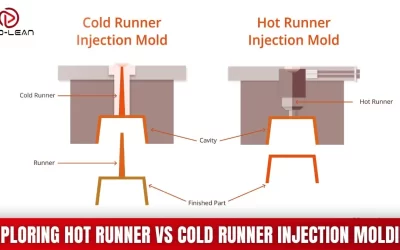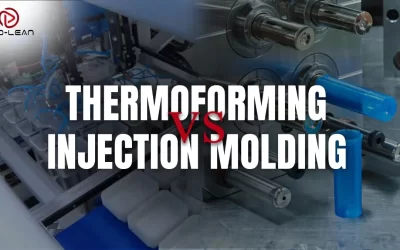“Medical Injection Molding is a significant manufacturing process in the healthcare industry. It involves the production of complex and precise medical components with the help of specialized machinery and materials.”

What is injection molding? It refers to the procedure of shaping medical equipment by injecting the molten plastic into a mold to melt the plastic resin and shape the melted material into a specific form. This process ensures effective control over the size and shape of the product and is subject to rigorous quality and regulatory standards. The Medical Injection Molding process helps in making durable and reliable products that are FDA-approved. Moreover, it plays a crucial role in prototype manufacturing. This process can be carried out in a clean room, and the manufactured products can be sterilized afterward.
In this article, we will deeply discuss medical injection molding and provide you with a comprehensive guide on its process, applications, and significance in the medical sector.
Different Materials for Medical Injection Molding
There are several medical injection molding materials available in the market that can help in manufacturing different FDA-approved components for the healthcare sector. The following are the detailed properties and applications of these materials;
Table: Material properties and applications for Medical Injection Molding
| Material Type | Properties | Applications |
| Thermoplastics |
Thermoplastics like Polypropylene (PP), Polyethylene (PE), Polystyrene (PS), and Polyetheretherketone (PEEK) are widely used in injection molding. They can be heated to a molten state and solidified upon cooling. Moreover, they are recyclable, versatile, and can be molded into complex shapes. |
|
| Thermosets | The thermostat such as Silicon, is cured and hardened during the molding process, which is why it is not recyclable. Moreover, it is typically more rigid and durable than thermoplastics. |
|
| Rubber | Rubber exhibits elastic properties. It has good resistance to abrasion and impact. |
|
Furthermore, you need to consider the various factors to choose the best material for injection molding based on the requirements of desired medical products, such as physical and chemical properties, medical standards, cost, etc.
Try Prolean Now!
Detailed Process of Medical Injection Molding
For the preparation of medical components, here is a detailed process of Medical Injection Molding;
1. Material Selection
The first step for medical injection molding is a selection of biocompatible material. The choice of materials is a complex decision. Because it can ultimately affect patient safety and product performance. So, these biocompatible materials include medical-grade plastics such as polycarbonate material, polyethylene, and polypropylene. They undergo rigorous testing to make sure they meet the industry’s standards for safety, biocompatibility, and stabilizability.
2. Tooling Design
After selecting the suitable material, the next step is mold design, also known as tooling design. This is considered the backbone of the medical injection molding process. This stage demands precision engineering.

Medical Injection mold
So, the created mold perfectly reflects the intended end product. During this stage, there is a wide use of advanced computer-aided design (CAD) and computer-aided manufacturing (CAM) technologies. Moreover, the tooling design stage also involves creating prototypes for tooling. So, the process can proceed with a tested and validated tooling design.
3. Injection Molding Machine Setup
Once the molds are created, they are expertly placed onto injection molding machines. This installation process requires a high level of technical expertise to guarantee that the molds are securely in place. After that, the selected medical-grade plastics are then heated to a molten state within the injection molding machine. It includes precise temperature control to avoid material degradation. Subsequently, the molten material is injected into the mold to fill every cavity to create the required medical component.

Injection molding machine
During the injection process, proper monitoring systems track variables such as temperature, pressure, and injection speed. This real-time monitoring helps in that each molded component sticks to the exact specifications according to the tooling design.
4. Cooling and Ejection
After injection, the molten material undergoes a controlled cooling process within the mold. This stage is important for preventing any kind of deformities in the final product. The cooling time is properly available on the machine. So it is easy to achieve the optimal balance between speed and thorough solidification.
So, once the cooling process is complete, the new medical components are gently ejected from the mold. Then each component goes through quality inspection. It includes thorough checks for dimensional accuracy, surface finish, and overall quality.
Advantages of Injection Molding for Medical Parts
The Medical Injection Molding process has defined its role in the healthcare industry for the massive production of medical devices. It is quite a smooth and effective process and offers the following several advantages;
- Wide Range of Material Choices
The process of medical injection molding allows for a diverse selection of materials. Although, this process narrows down the range of available materials. But, there are still many options suitable for the production of medical-grade components.
- Cost-Efficiency
The process of medical injection is designed to reduce unnecessary expenses in injection molding. It facilitates large-scale production and high-volume manufacturing. Hence, when there is an exceptional quantity of medical injection components, the injection molding process can help minimize per-piece costs.
- Stability
A well-known fact about thermoplastic used in injection molding is its exceptional stability. These materials provide resistance against factors such as abrasion, negative environmental conditions, and overall wear and tear. Resultantly, the manufactured product easily bears heat, mechanical stress, and compression without experiencing deformation or breakage. Moreover, autoclave sterilization does not affect them. It makes them resistant to microbial contamination.
- High Accuracy
In the medical injection process, high accuracy and precision are important. The margins of error can impact the entire manufacturing of molding by inches, millimeters, or centimeters. So, to get this high level of surface precision injection moulding facilities are required.
- Resistance Against Contamination
The materials used in this manufacturing process effectively resist contamination attacks. Moreover, they do not require extensive encapsulation to stay germ-free. This feature allows the materials to easily meet the standards set by the FDA and other mandated requirements.
Applications of Medical Injection Molding
Because of high accuracy, precision, and modern innovative solutions, medical injection molding is playing a significant role in manufacturing numerous medical products. So, these products are highly in demand in the medical world. Here are some important applications for this process;

Medical parts created with injection molding
- Production of syringes and needles.
- Creating implantable devices, such as joint replacements and dental implants.
- Manufacturing of diagnostic equipment components including housings, connectors, and sensor components.
- Production of surgical Instruments.
Try Prolean Now!
Prolean Injection Molding Services for Medical Devices and Parts
At Prolean, we offer injection molding services for medical applications, from equipment housing to implants. Get your FDA or other standard-approved medical parts from us!
Our comprehensive services in injection molding from mold design to the surface finish include;
- Custom mold design and manufacturing according to your specifications
- Health-conscious injection molding for plastics and metals
- High-quality control measures
- Post-molding operations such as painting and polishing
- Rapid prototyping for swift design verification
- Large-scale production capabilities for high-volume requirements
Get your injection molding quote today!
Summing Up
In summary, medical Injection molding plays an essential part in the medical world. It provides a well-aligned and efficient method for producing high-quality, precise, and FDA-approved medical components. Its advantages in material selection, cost-efficiency, stability, accuracy, and resistance make it a preferred choice for the massive production of medical devices. Thus, the medical injection molding process is contributing significantly to advancements in healthcare technology.
FAQs
What is silicon injection molding?
Silicone injection molding is a specific type of injection molding process used to manufacture parts and products made from silicone elastomers. Silicone is a versatile material known for its flexibility, heat resistance, chemical stability, and biocompatibility. This makes it significant in medical device manufacturing
What is the principle of molding?
The fundamental principle of injection molding is straightforward. The plastic material is heated until it transforms into a thick, molten state. Afterward, it is pushed into a sealed mold that determines the shape of the final product.
Why do industries use CNC milling in medical device manufacturing?
In the manufacturing industry, CNC milling for medical devices due to its precision, plays a vital role. It helps in getting exact geometry, consistent quality, and compliance with high regulatory standards.




0 Comments